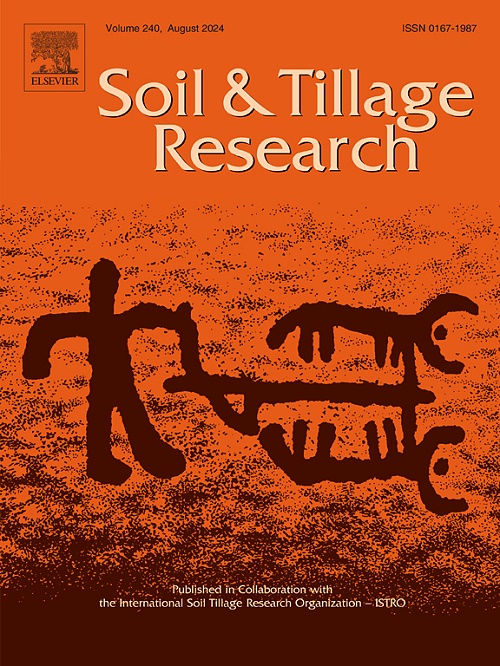Exploring the role of intercrops in enhancing soil enzyme activities and nutrient cycling in maize cultivation: A four-year field study
IF 6.8
1区 农林科学
Q1 SOIL SCIENCE
引用次数: 0
Abstract
Undersowing cash crops with intercrops offers significant benefits for soil health and crop production. In response to the growing interest in maize undersowing, a four-year field experiment was conducted to evaluate the effects of various undersown intercrops, including grasses, cereals, and legumes, on microbial transformation and mineralization activities as well as the balance of these processes in relation to nutrient uptake and availability for plants and soil microbes.
The study demonstrated that undersowing maize in strips had a positive effect on biological soil properties. The enhancement of soil enzyme activities involved in nutrient transformation varied depending on the soil properties and climatic conditions in each of monitored years (2020–2023), and the type of intercrop used. The most significant changes in nutrient fluxes in the topsoil, as evidenced by C, N, P, S mineralizing enzymes and their microbial nutrient acquisition ratios, were observed in plots undersown with phacelia, crimson clover and perennial ryegrass. These changes were closely linked to the presence of intercropped plants and were not observed in the control interrows of the maize pure stand.
Undersowing was associated with increased nitrogen acquisition ratios (indicating higher demand for mineral nitrogen), as well as elevated activities of nitrogen-transforming (urease) and carbon-transforming (dehydrogenase, β-glucosidase) enzymes. All undersown treatments also enhanced phosphorus- and sulphur-mineralizing activities, in contrast to the maize, which pure stand exhibited reduced activity related to these nutrients.
Despite these improvements in soil biological properties, the enhancement did not translate into increased maize biomass for silage or grain yield. Nonetheless, the study underscores the potential of maize undersowing with intercrops in strips to improve soil fertility and nutrient cycling, thereby contributing to the long-term sustainability of agricultural systems.
探究间作在玉米栽培中提高土壤酶活性和养分循环中的作用:一项为期四年的田间研究
经济作物下播间作对土壤健康和作物生产有显著的好处。为了响应对玉米暗播日益增长的兴趣,进行了一项为期四年的田间试验,以评估各种暗播间作(包括草、谷物和豆类)对微生物转化和矿化活动的影响,以及这些过程与植物和土壤微生物的养分吸收和有效性相关的平衡。研究表明,玉米条播对土壤生物性状有积极影响。参与养分转化的土壤酶活性的增强取决于监测年份(2020-2023年)的土壤性质和气候条件,以及间作类型的不同。表层土壤中C、N、P、S矿化酶及其微生物养分获取比变化最为显著的是长穗草、深三叶草和多年生黑麦草。这些变化与间作植物的存在密切相关,而在玉米纯林分的对照间作中没有观察到。深播增加了氮素获取率(表明对矿物氮的需求增加),提高了氮转化(脲酶)和碳转化(脱氢酶、β-葡萄糖苷酶)酶的活性。与玉米相比,所有的地下处理都提高了磷和硫矿化活性,而玉米的纯林分表现出与这些养分相关的活性降低。尽管土壤生物学特性得到了改善,但这种改善并没有转化为青贮玉米生物量或粮食产量的增加。尽管如此,该研究强调了玉米间作条播在改善土壤肥力和养分循环方面的潜力,从而有助于农业系统的长期可持续性。
本文章由计算机程序翻译,如有差异,请以英文原文为准。
求助全文
约1分钟内获得全文
求助全文
来源期刊

Soil & Tillage Research
农林科学-土壤科学
CiteScore
13.00
自引率
6.20%
发文量
266
审稿时长
5 months
期刊介绍:
Soil & Tillage Research examines the physical, chemical and biological changes in the soil caused by tillage and field traffic. Manuscripts will be considered on aspects of soil science, physics, technology, mechanization and applied engineering for a sustainable balance among productivity, environmental quality and profitability. The following are examples of suitable topics within the scope of the journal of Soil and Tillage Research:
The agricultural and biosystems engineering associated with tillage (including no-tillage, reduced-tillage and direct drilling), irrigation and drainage, crops and crop rotations, fertilization, rehabilitation of mine spoils and processes used to modify soils. Soil change effects on establishment and yield of crops, growth of plants and roots, structure and erosion of soil, cycling of carbon and nutrients, greenhouse gas emissions, leaching, runoff and other processes that affect environmental quality. Characterization or modeling of tillage and field traffic responses, soil, climate, or topographic effects, soil deformation processes, tillage tools, traction devices, energy requirements, economics, surface and subsurface water quality effects, tillage effects on weed, pest and disease control, and their interactions.
 求助内容:
求助内容: 应助结果提醒方式:
应助结果提醒方式:


